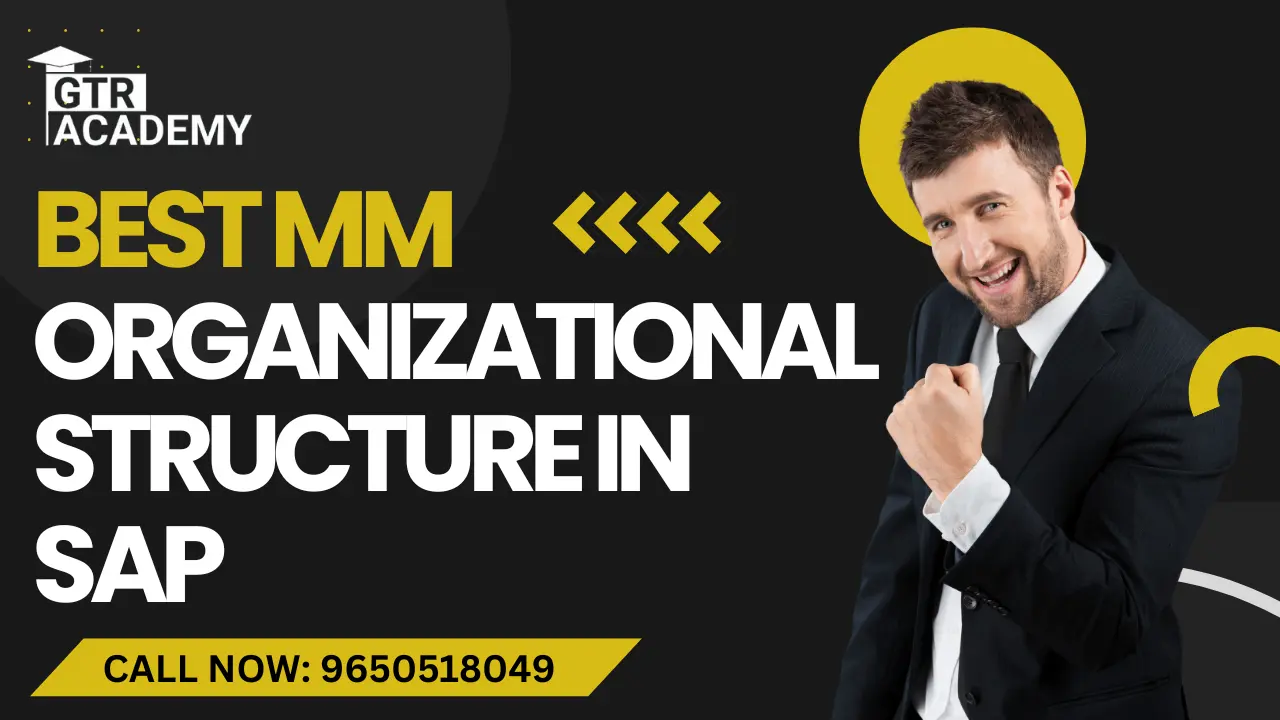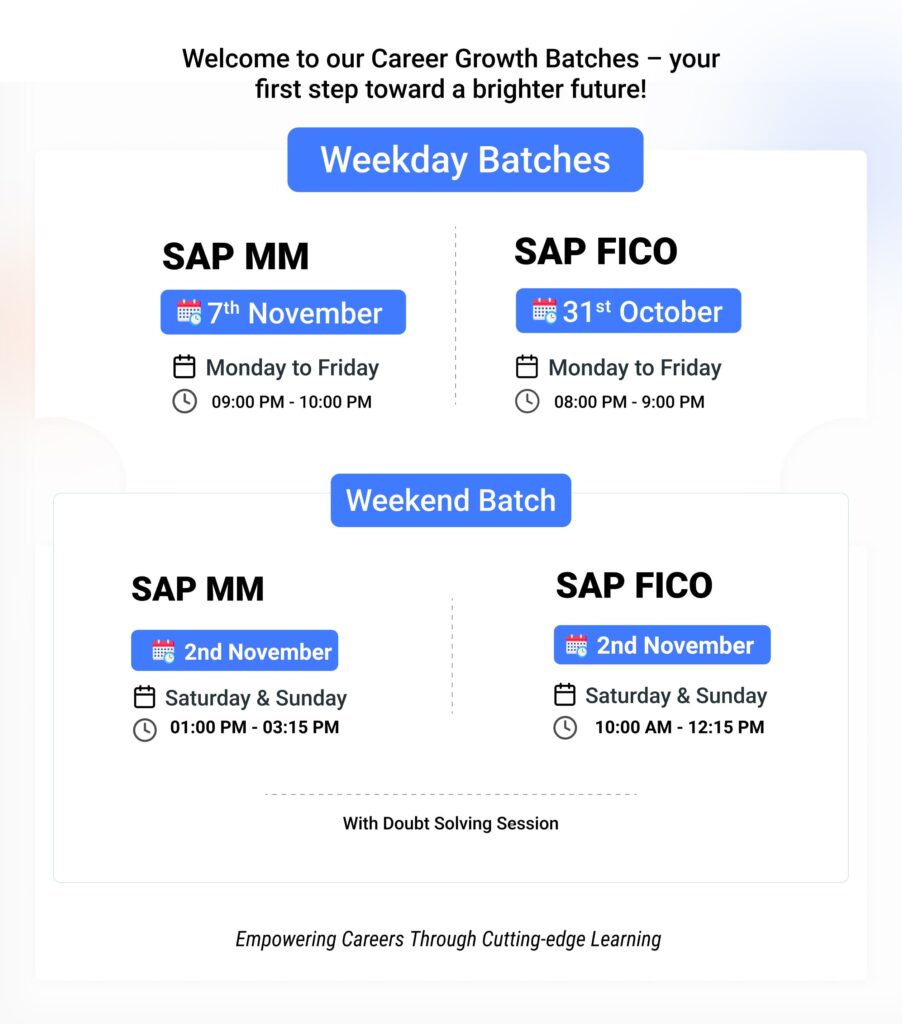MM Organizational Structure in SAP – A Complete Guide (2025)
In the world of enterprise resource planning, SAP MM (Materials Management) plays a vital role in managing procurement, inventory, and logistics. To make these processes efficient and structured, SAP uses a clear organizational structure. Understanding the MM Organizational Structure in SAP is essential for anyone learning SAP MM or planning a career as an SAP consultant.
If you’re a beginner or preparing for interviews, this guide will help you understand how SAP MM organizational structure works, its key elements, and how to configure it step by step.
Connect With Us: WhatsApp

What is an Organizational Structure in SAP MM?
The organizational structure in SAP MM defines how a company is organized in the system for materials management and procurement. It represents different business units, such as companies, plants, storage locations, and purchasing organizations, and how they are connected to each other.
In simple terms, it is the hierarchical setup that controls how materials and purchasing activities are managed across the company. Each level in this structure serves a specific purpose and helps SAP integrate various business processes efficiently.
Why Is the Organizational Structure Important in SAP MM?
The organizational structure helps SAP MM users:
-
Control the flow of materials and goods within the company.
-
Manage purchasing and inventory systematically.
-
Assign responsibilities to different departments and plants.
-
Maintain accurate records of transactions across business units.
-
Generate reports based on specific company codes or plants.
Without a clear structure, it would be difficult to track materials, handle suppliers, or manage purchases efficiently.
Key Components of MM Organizational Structure in SAP
Let’s look at the main elements that form the SAP MM organizational structure:
1. Client
At the top of the hierarchy is the Client.
It represents the highest level in the SAP system and refers to the entire enterprise. Every data or configuration created under a client is accessible to all its company codes and plants.
Example: If GTR Group runs multiple companies under one SAP system, the Client represents GTR Group as a whole.
2. Company Code
The Company Code is the legal entity for which financial statements such as balance sheets and profit & loss accounts are created.
Each company code operates independently but can share data within the same client.
Example: GTR India Pvt. Ltd. and GTR USA Inc. can each have their own company code.
3. Plant
A Plant is a physical or logical location where materials are manufactured, stored, or distributed.
It is a key component in SAP MM because most materials management activities — such as inventory control, material valuation, and purchasing — take place at the plant level.
Example: A factory, warehouse, or distribution center can be a plant.
4. Storage Location
The Storage Location represents specific places within a plant where materials are stored physically.
It helps keep track of stock levels, material movements, and goods receipts at a detailed level.
Example: A warehouse can have separate storage locations for raw materials, finished goods, or spare parts.
5. Purchasing Organization
The Purchasing Organization is responsible for procurement activities such as purchasing materials and negotiating with vendors.
It can serve a single company code or multiple company codes depending on how the company operates.
Example: GTR Academy might have a central purchasing organization that buys materials for all its training centers across different cities.
6. Purchasing Group
The Purchasing Group represents a person or group of people responsible for specific purchasing activities.
It’s more of an operational unit that handles purchase orders and vendor communications.
Example: A purchasing group can be assigned for IT equipment, another for office supplies, and another for training materials.
MM Organizational Structure in SAP – Example
Let’s understand with an example:
Imagine GTR Academy, one of the best SAP training institutes, operates across India.
Its organizational structure in SAP MM can look like this:
-
Client: GTR Academy Group
-
Company Code: GTR Academy Pvt. Ltd.
-
Plant: GTR Bangalore Campus, GTR Delhi Campus
-
Storage Location: Classroom Materials, Lab Equipment, Library Stock
-
Purchasing Organization: GTR Central Procurement
-
Purchasing Group: Trainers Group, IT Group, Admin Group
This setup allows GTR Academy to manage materials like laptops, projectors, books, and other resources efficiently in SAP.
How to Configure MM Organizational Structure in SAP
Configuration of the organizational structure in SAP MM is done in the SPRO (SAP Project Reference Object) area.
Steps:
-
Go to SPRO → SAP Reference IMG
-
Navigate to Enterprise Structure → Definition → Materials Management
-
Define the following:
-
Company Code
-
Plant
-
Storage Location
-
Purchasing Organization
-
Purchasing Group
-
-
Assign Relationships:
-
Assign Company Code to Company
-
Assign Plant to Company Code
-
Assign Purchasing Organization to Company Code or Plant
-
Assign Purchasing Group as needed
-
-
Save the configuration
Once configured, this structure forms the backbone of all MM activities like purchasing, goods receipt, and inventory management.
MM Organizational Structure in SAP S/4HANA
In SAP S/4HANA, the organizational structure remains similar but with improved integration, faster performance, and simplified reporting.
The core components — Client, Company Code, Plant, Storage Location, and Purchasing Organization — continue to exist, but configuration and navigation have become more user-friendly through Fiori apps.
MM Organizational Structure in SAP – PDF and PPT Resources
If you are learning SAP MM, having access to resources like SAP MM Organizational Structure PDFs, Configuration Guides, or PPT Presentations can help you visualize the setup easily.
Many training platforms, including GTR Academy, provide downloadable SAP MM PDFs and step-by-step configuration guides for students.
Learn SAP MM Organizational Structure with GTR Academy
If you want to learn how to configure and manage the SAP MM Organizational Structure, GTR Academy is one of the best choices for your SAP journey.
GTR Academy offers:
-
Expert-led SAP MM training and certification programs
-
Online SAP courses with certificates
-
Live practical sessions on SAP S/4HANA
-
Affordable SAP course fees
-
Placement support for SAP MM Consultant roles
With practical training and real SAP server access, GTR Academy helps students and professionals gain real-world experience in SAP MM.
Top 10 FAQs About MM Organizational Structure in SAP (2025)
1. What is the MM Organizational Structure in SAP?
The MM Organizational Structure in SAP represents the framework that defines how a company’s materials management and procurement processes are organized. It includes components like Client, Company Code, Plant, Storage Location, Purchasing Organization, and Purchasing Group.
2. Why is the Organizational Structure important in SAP MM?
It helps manage and control purchasing, inventory, and material flow across the company. A well-defined structure ensures smooth integration between financial, logistics, and production modules in SAP.
3. What are the main elements of the MM Organizational Structure in SAP?
The key elements include:
-
Client – Top-level structure representing the enterprise.
-
Company Code – Legal entity for financial reporting.
-
Plant – Location where materials are produced or stored.
-
Storage Location – Subdivision of a plant for storing materials.
-
Purchasing Organization – Handles procurement activities.
-
Purchasing Group – Manages day-to-day buying operations.
4. What is the difference between a Company Code and a Plant?
A Company Code represents a legal financial entity, while a Plant is a location within the company where materials are manufactured or stored. A single company code can have multiple plants assigned to it.
5. How do you configure the Organizational Structure in SAP MM?
Configuration is done using Code SPRO → Enterprise Structure → Definition → Materials Management.
You define elements like Company Code, Plant, Storage Location, and Purchasing Organization, then assign them correctly under “Assignments.”
6. What is the role of a Purchasing Organization in SAP MM?
A Purchasing Organization is responsible for buying goods and services, negotiating with vendors, and managing purchase contracts. It ensures procurement is handled efficiently and legally for the assigned company or plant.
7. What is a Storage Location in SAP MM?
A Storage Location is a specific physical area within a plant where materials are kept. It helps track stock quantities, manage inventory, and organize materials based on categories or purposes.
8. How does the MM Organizational Structure integrate with other SAP modules?
The MM structure integrates closely with:
-
FI (Financial Accounting) through Company Code
-
PP (Production Planning) through Plant
-
SD (Sales and Distribution) through Material Master and Plant assignments
This integration ensures all departments share accurate, real-time data.
9. What are common interview questions about MM Organizational Structure?
Common interview questions include:
-
What is the difference between a Plant and a Storage Location?
-
How do you assign a Purchasing Organization to a Company Code?
-
Can multiple plants share the same Purchasing Organization?
-
Explain the role of a Client in SAP MM.
10. Where can I learn MM Organizational Structure and SAP MM configuration?
You can learn from GTR Academy, one of the best SAP training institutes offering SAP MM courses.
GTR Academy provides:
-
Expert-led SAP MM online training and certification
-
Access to SAP practice servers
-
Step-by-step guides and PDFs on MM configuration
-
Affordable SAP course fees and placement assistance
With GTR Academy’s SAP MM training, you can gain practical experience, learn configuration from scratch, and prepare for real-world SAP MM consultant roles.
Connect With Us: WhatsApp
Conclusion
The MM Organizational Structure in SAP is the foundation of all materials management and procurement processes.
By understanding and configuring its elements — Client, Company Code, Plant, Storage Location, and Purchasing Organization — businesses can achieve seamless integration and control over their supply chain operations.
Whether you’re a fresher, working professional, or SAP aspirant, mastering the organizational structure in SAP MM is the first step toward becoming a successful SAP MM Consultant.
For hands-on training, expert guidance, and certification, join GTR Academy’s SAP MM course and start building your SAP career today!








